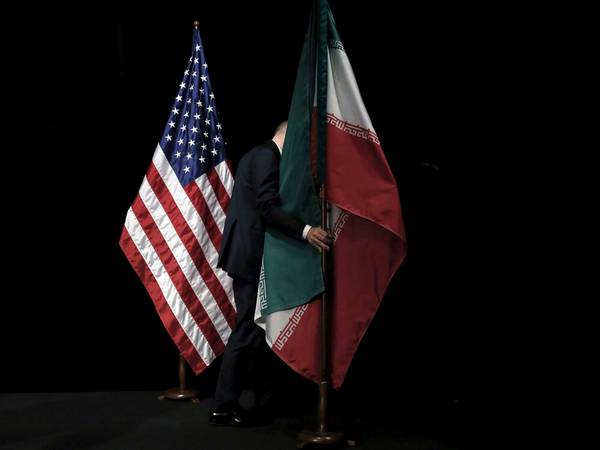Tensions between Iran and the West are reaching new heights as the fate of nuclear talks hangs in the balance, and missile restrictions are expiring in October.
Multiple reports have been indicating that ‘secret’ talks are underway between Iranian and western officials over the possibility of reaching an “informal, unwritten agreement” or a "political ceasefire" between the two sides.
Iran, for its part, has confirmed that it held indirect talks with the US in Oman. However, these talks have yet to yield concrete results while Iran’s nuclear crisis remains dangerously unresolved, fueling a ripple effect across the region, forcing new alliances with the likes of the Persian Gulf states and new threats from Israel.
According to the IAEA, Iran’s total stockpile of enriched uranium continues to grow and is now 23 times the limits imposed by the 2015 deal, also known as the JCPOA. Accordingly, Iran remains a “nuclear threshold state” since it is in the possession of means to “produce enough material for a nuclear bomb in 12 days.”
The Islamic Republic regime continues to suffer from a crisis of legitimacy, at least internally, as a direct consequence of the bloody crackdown of an unprecedented popular uprising in September 2022, which was triggered by the death in custody of Mahsa (Zhina) Amini.
Therefore, the Islamic Republic’s recent policy of regional détente (i.e., with Saudi Arabia) and its proclivity for negotiations with the US over its nuclear program can be viewed as a Russian-style deception tactic (maskirovka) aimed at confusing and outfoxing its ‘western enemies’ while minimizing the negative international backlash against its inhumane behavior at home and its destabilizing activities abroad, namely in Ukraine.
In a worrying sign of growing tensions between Iran and the West, the UN sanctions on Iran’s ballistic missiles program will be lifted on October 18 as per the JCPOA’s so-called “sunset-clauses”. The expiration of the UNSCR 2231’s missile restrictions on Iran means, at least on paper, that in less than four months, the Islamic Republic regime can legally supply deadlier drones and ballistic missiles to Russia for its ongoing military aggression in Ukraine. The situation for the Biden administration is not irredeemable but could not be worse.
Not only has Iran’s nuclear program reached a point of no return (at least theoretically), the specter of Iran’s possible provision of ballistic missiles to Russia for use in its war against Ukraine, is looming large.
Had the Biden administration adopted a serious and meaningful deterrence strategy vis-à-vis Iran before the Russian invasion of Ukraine, an undesirable status-quo of today could have been prevented in the first place or it could have, at least, been managed in a much more timely, less costly, and effective manner.
For so long, the Biden administration and European powers hesitate to activate the “snapback” mechanism of UN Security Council Resolution 2231 against Iran, fearing that such a move could dissuade Tehran from engaging in nuclear talks and/or prompt the regime to opt for a dangerous nuclear escalation.
The reality is that absent a meaningful deterrence strategy vis-à-vis Iran, the West has in fact created a catch-22 situation from which it cannot escape without sustaining relatively high costs.
Simply put, if “snapback” is activated, Iran is likely to resort to regional and nuclear escalation. Conversely, if the mechanism is not activated, the clerics would rejoice in their notion of “western capitulation” to Tehran, and use every opportunity to threaten the west with more weaponry for Russia in Ukraine war while enjoying the status of a “nuclear threshold state.”
More than 16 months into the Ukraine war, Tehran continues to transfer kamikaze drones, including Shahed 136s to Russia in spite of EU/US sanctions on Iranian entities involved in the drone industry.
The threats posed by the Islamic Republic are hybrid in nature, in the sense that they encompass a wide variety of threats such as nuclear, drones, ballistic missiles, cyber and overseas terror operations against dissidents.
Effective and enduring deterrence against these hybrid threats requires the Biden administration to avoid short-term remedies that seek only to kick the Iranian nuclear can down the road. The US should, instead, adopt a comprehensive and all-encompassing strategy vis-à-vis Iran. Putting off solving Iran’s nuclear crisis is not the solution.
It was thanks to the Ukraine war that European countries became aware of some of the oft-ignored threats of the Islamic Republic beyond its borders.
Imagine a future war between the US and China over Taiwan and Europeans at the horns of a dilemma to choose between the US (their biggest military ally) and China (their biggest economic partner). Imagine the worst-case-scenario whereby Iran-made drones would fly over some European cities in support of China and as a leverage against the United States.
While Putin’s Russia is seen as the West’s foremost threat, the United States and European powers should not underestimate the hybrid threats of the Islamic Republic regime.
Opinions expressed in the analysis are not necessarily the views of Iran International
